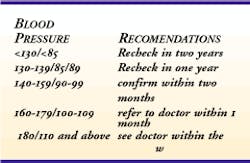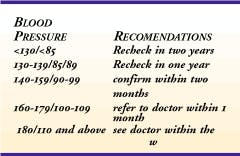Hypertension
The `silent killer` presents unique challenges for dental teams.
Connie Sidder, RDH, B.S.
Twenty five years ago, I was selling dental supplies for Codesco (now Burkhart Dental Supply Co.). We had just started carrying blood pressure cuffs, and I was actively marketing them to my clients. At one office, the hygienist and assistant asked me to approach the dentist and persuade him to buy one. Recently, a patient had a heart attack in the office. She survived, but was hospitalized for six weeks in ICU. The doctor, however, declined to purchase the equipment.
It is estimated that one-third of all people with high blood pressure go undiagnosed. As baby boomers age, many are keeping up with dental treatment, but they neglect to visit the doctor regularly. Dental hygienists are a readily available source of information. They have marvelous opportunity to strengthen their credibility as healthcare professionals with their patients.
Carefully reviewing a patient`s medical history can alert us to previously undetected conditions. A patient presenting with excessively hemorrhagic gums may in fact be over-medicating with aspirin. Ask the patient if he or she knows what their blood pressure is. If not, offer to take it immediately.
Hypertension - also known as the "silent killer" - occurs when the body`s smaller blood vessels (arterioles) narrow, which, in turn, cause the blood to exert pressure against the arterial wall. Several factors contribute to high blood pressure. About on-third of affected patients are overweight. Smoking greatly increases the risk, while dietary factors such as caffeine and alcohol consumption can also contribute. In the general population, 25 percent of all adults have high blood pressure. African-Americans have a higher incidence, with over 50 percent of males, and slightly smaller percentage of women, affected. Those living in the southeastern United States have a higher incidence of hypertension and stroke.
The numbers used to calibrate blood pressure are called systolic and diastolic. The systolic reading, which is the first and higher number, measures the heart`s contractions as it pumps blood out. The diastolic reading, the lower number, measures blood flow into the heart as it relaxes. Blood pressure is categorized as normal, high normal, mild, moderate, severe, and very severe. See the adjacent table for guidelines.
The medications used to control high blood pressure vary in their approaches. More than 50 drugs are used to treat hypertension. Many have unpleasant side effects, although the newer versions are improving. The first treatment of choice is diuretics, which reduce water and salt. The other classes of hypertensive therapy include angiotensin converting enzyme (ACE) inhibitors, vasodilators, calcium channel blockers, and alpha and beta blockers. See the table below for examples and their actions.
Nondrug therapies for hypertension have only recently come into vogue. Historically, people with hypertension took medication for life. Nowadays, moderate lifestyle changes and following the DASH (Dietary Approaches to Stop Hypertension) diet allows some people to reduce their medication or stop taking it altogether.
Hygienists should familiarize themselves with the medications used for treating hypertension. They should also learn to recognize their effects on oral health. For example, patients on Ca blockers may experience gingivitis and increased bleeding during surgery. ACE inhibitors commonly cause dry mouth and an irritating cough. Hygienists could prescribe home fluoride treatments to counteract this effect.
A blood pressure cuff with stethoscope costs about $22 for a basic model, and $40 for a low-end digital model - a modest investment with a potentially life-saving payoff. Do you know your blood pressure?
Connie L. Sidder, RDH, BS, is based in Fort Collins, Colo. She can be reached by telephone at (970) 482-4649 or by e-mail at

